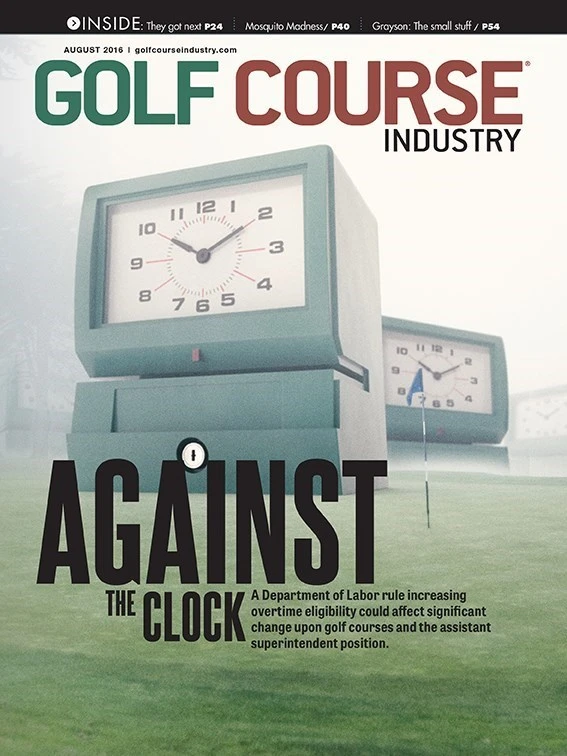A shaper who has spent a career building greens for architects that never drew plans, once told me, “It’s easier if the architect can at least tell me what he wants for the basic angle of the green, relative to the line of play.” After all, there is a 180 degree range of possibilities, reducing the shapers chances of guessing right. And, while details can be moved around, guessing wrong on the basic orientation usually results in having to rebuild, nearly from scratch.
As an architect who does do green plans I pre-think the basic green angle well in advance of the bulldozers arrival. To my way of thinking, the basic green axis/angle is vastly underappreciated as a design element, but several factors point to its importance.
Statistically, the USGA Slope Guide shows greens need to be deeper than wide for the majority of average golfers to play them. Greens turned across the line naturally reduce depth, often unnecessarily. Such greens are nearly impossible for the average golfer to hit and hold.
Even greens at 45-degree angles are hard. On a long, narrow green with three to four club difference from front to back pins, golfers must match the perfect angle to correct distance to hit the green, often missing the green with a fairly decent shot.
From the basic premise that most greens need their long axis generally aligned to the line of play to provide adequate depth, there is still the design question of “how many degrees off center is acceptable?” I determine the approximate green angle using a few basic factors.
Most often, I follow natural contours. If the green site contour runs 10 degrees to the right, the green usually angles about 10 degrees right. Greens that fight against the natural slope usually look unnatural and often require too much drainage and earthwork to be practical. The steeper the general directional slope, the more likely the green is angle with it. On flatter sites, we can more easily alter contours and base the green angle/axis on golf-related design parameters, which include, in approximately the following order:
APPROACH SHOT LENGTH. Top golfers can stop approach shots on a dime, which is exceptionally difficult for average golfers with lower ball flight and spin. Holding greens becomes increasingly difficult on longer approach shots, where many golfers need room to “run out” their approach shots. Greens for long approach shots should be aligned closely to the line of play, while the angle/orientation can gradually increase as the expected approach shot shortens.
My very general (and oft broken) rule of thumb about 1-3 degrees per club and adjusted for wind, lie, etc. On public courses, we favor lower angles, expecting many poor tee shots to result in longer than the “expected” approach shot length.
FAIRWAY WIDTH. Strategically, architects often ask golfers to place tee shots on one side of the fairway for a better approach angle. For similar green designs, 100-yard approach shots require less fairway width than 200-yard shots. Conversely, where the architect controls fairway width by design, wider fairways allow steeper green angles. On older tree-lined courses, smaller green tilt can achieve the same strategic effect.
PREVAILING WIND. Where wind is fairly predictable, crosswinds and headwinds increase shot “bend” and headwinds add spin to reduce roll out. Tailwinds reduce spin, add roll out and straighten shots. We might add a few degrees in headwinds, and typically reduce the angle for downwind shots, to best fit the likely shot patterns.
VISUAL PRESENTATION. Greens appear to be more sharply angled at ground level than in plain view. Greens canting 30 or more degrees usually appear to angle much more, depending on design details, often looking scarier than accommodating. The “1-3 degrees per club” rule of thumb also helps avoid this visual phenomenon.
COURSE BALANCE. While I have never achieved perfect course balance, theoretically, over 18 greens, an “ideal” pleasant, but reasonable and balanced test of golf would include a similar number of greens angling left and right, with:
- One or two greens angled at zero degrees
- One or two greens maximum at 45 degrees
- One to four greens angled from 50-90 degrees, mixed appropriately on a variety of par 3, 4 and 5 holes. I often use shallow greens on the longest par 3 and par 4 hole, figuring average players often come up short, approaching with a wedge, while it tests distance control for better players.

Explore the August 2016 Issue
Check out more from this issue and find your next story to read.
Latest from Golf Course Industry
- The Cabot Collection announces move into course management
- Carolinas GCSA raises nearly $300,000 for research
- Advanced Turf Solutions’ Scott Lund expands role
- South Carolina’s Tidewater Golf Club completes renovation project
- SePRO to host webinar on plant growth regulators
- Turfco introduces riding applicator
- From the publisher’s pen: The golf guilt trip
- Bob Farren lands Carolinas GCSA highest honor






